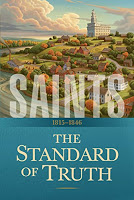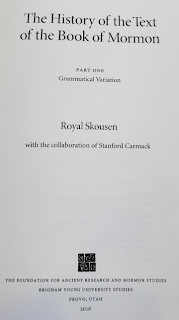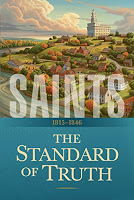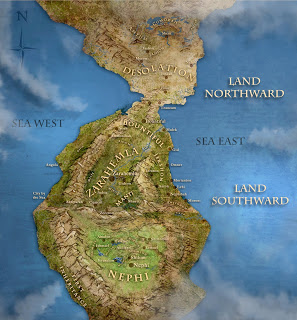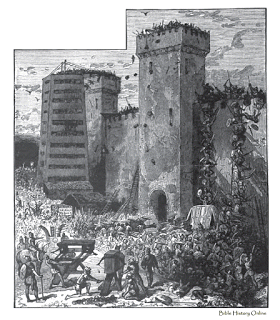Why Saints censors key history
I’m very enthusiastic about the renewed emphasis on Church history. Everyone is reading Saints, which is awesome.
But there is another aspect of the tragedy of Saints to consider.
Because the book censors all references to the New York Cumorah, it reinforces skepticism about Church history.
Think about this: a book titled “The Standard of Truth” deliberately censors a key teaching of the founding prophets, their contemporaries and their successors.
Fortunately, there is still plenty of time to correct this censorship in the digital editions, but that correction will not happen as long as M2C* prevails.
Imagine how much more powerful the book Saints would be if it educated the Latter-day Saints about these historical facts instead of censoring them.
_____
Remember that the top two reasons Millennials give for leaving the Church are
– “I felt judged or misunderstood.”
– [tied for first] “I did not trust the Church leadership to tell the truth surrounding controversial or historical issues.”
https://religionnews.com/2017/01/27/do-mormons-leave-the-church-because-they-got-offended/
Saints is making the problem even worse by reinforcing the perception that the Church doesn’t tell the truth about its history.
As a result of the pervasive censorship about the New York Cumorah, critics of the Church know more about this problem than most members do. E.g., http://www.utlm.org/onlineresources/cumorah.htm
Imagine what the youth of the Church (and investigators) think when they learn the truth about the New York Cumorah from critics instead of their CES/BYU teachers (and the missionaries).
_____
Thanks to our M2C intellectuals, we have Visitors Centers, Institute and Seminary manuals, BYU/CES, and the Church History Department all teaching that Cumorah cannot be in New York. Instead, they tell people that there are “two Cumorahs.” They say the “real Cumorah” is in Mexico, while the “hill in New York” was falsely named Cumorah by early Church members, thereby creating a false tradition that Joseph Smith passively adopted.
And now Saints solidifies M2C by censoring all references to the New York Cumorah.
The M2C promoters don’t even tell students that the prophets and apostles have taught the New York Cumorah consistently for 180 years, including in General Conference. When a student finds out and asks about it, their BYU/CES teachers claim the prophets and apostles were wrong.
It’s a double-whammy.
First, through their censorship of Letter VII and the New York Cumorah generally, the M2C intellectuals (and Saints) don’t tell the truth about what prior Church leaders have taught, thereby reinforcing the main reason why Millennials leave the Church.
Second, the M2C intellectuals claim the prophets and apostles are wrong, which, if true, leads people to wonder why we have prophets and apostles in the first place. What can possibly be more destructive to faith than having BYU/CES teachers telling students the prophets and apostles are wrong?
_____
Here is a table of examples of censorship in the first volume of Saints. There are more examples, and there will be more in the next three volumes, but this gives you an idea of the magnitude of the problem.
|
Event
|
Treatment in Saints
|
Justification by M2C intellectuals
|
|
During his first visit to Joseph, Moroni “proceeded and gave a general account of the promises made to the fathers, and also gave a history of the aborigenes of this country… He said this history was written and deposited not far from that place” [meaning Joseph’s home].
|
Censored.
Saints changed all references to “this country” and “this continent” to the generic term “the Americas” to accommodate M2C.
None of the original documents used the term “the Americas” in connection with the Book of Mormon.
|
Oliver and Joseph were wrong.
They either didn’t quote Moroni correctly, or when Moroni said “this country” he really meant Mesoamerica.
Also, Moroni didn’t mean the record was written not far from Joseph’s home; it was actually written in Mesoamerica.
|
|
Moroni told Joseph the hill was named Cumorah even before Joseph got the plates.
Lucy Mack Smith described an event that occurred when Joseph was returning from Manchester in 1827, before he got the plates. He was late coming home, and his parents questioned him about where he was. He explained he’d had a sever chastisement and his father became angry, wanting to know who had harassed Joseph. Lucy reported Joseph’s response in a direct quotation.
“Stop, father, Stop.” said Joseph, “it was the angel of the Lord— as I passed by the hill of Cumorah, where the plates are, the angel of the Lord met me and said, that I had not been engaged enough in the work of the Lord…”
|
Censored.
Note: In the Joseph Smith Papers, this passage isn’t even indexed under “Cumorah” so readers can’t find it when they search for Cumorah.
|
Lucy Mack Smith was wrong.
She must have been confused, or she conflated her account with the false tradition about the New York Cumorah started by Oliver Cowdery or someone else.
|
|
When David Whitmer was taking Joseph Smith and Oliver Cowdery from Harmony, PA, to Fayette, NY, he met a divine messenger who said he was taking the plates to Cumorah.
During the interview, Whitmer said he, Oliver and Joseph were riding in a wagon on the way to Fayette when a man appeared next to the wagon. “I invited him to ride if he was going our way. But he said very pleasantly, “No, I am going to Cumorah.’ This name was something new to me, I did not know what Cumorah meant. We all gazed at him and at each other, and as I looked round enquiringly of Joseph the old man instantly disappeared, so that I did not see him again….It was the messenger who had the plates, who had taken them from Joseph just prior to our starting from Harmony.”
Millennial Star (Vol. 40, No. 49, Dec. 9, 1878, p. 769, online here, scroll down to Dec. 9 and open the first file) titled “Report of Elders Orson Pratt and Joseph F. Smith.”
another example of censorship of this account is here:
|
Censored.
This account was also censored in the recent Church films about Harmony and Fayette.
It was also censored and even changed in the book Opening the Heavens, edited by brother John W. Welch, who is also Editor-in-Chief of BYU Studies and Chairman of Book of Mormon Central.
|
David Whitmer was wrong.
Although he repeated this account multiple times with a lot of detail, David was either mistaken, confused, or conflated this account with the false tradition about the New York Cumorah.
This account was given in a formal and public report to the Quorum of the Twelve by two Apostles, but Church members today should not ever be told about it.
|
|
During the mission to the Lamanites, Oliver Cowdery explained that it was Moroni who named the hill in New York Cumorah.
“This Book, which contained these things, was hid in the earth by Moroni, in a hill called by him, Cumorah, which hill is now in the State of New York, near the village of Palmyra, in Ontario county.”
Autobiography of Parley P. Pratt, p. 57
_____
By the way, Saints doesn’t even quote the revelations that called Oliver, Parley and others (D&C 28, 30, 32) on the mission to the Lamanites. Instead, Saints substitutes “American Indians” for “Lamanites” in this passage: “The revelation then called Oliver to go nearly a thousand miles to the western edge of the United States to preach the restored gospel to American Indians, who were remnants of the house of Israel…. The Lord called Peter Whitmer, Jr., Ziba Peterson, and Parley Pratt to join Oliver on the mission to the west.”
The Joseph Smith Papers goes so far as to use quotation marks to distance the intellectuals from the revelations: The link between the Book of Mormon peoples and the American Indians appears in connection with the mission of Oliver Cowdery and others to preach to the “Lamanites” in 1830–1831.”
|
Censored.
|
Parley P. Pratt was wrong.
He either mis-remembered when he wrote his journal, or he was repeating the false tradition.
Speaking of the mission to the Lamanites, notice how Saints and the Joseph Smith Papers change the terminology of the revelations to American Indians instead of Lamanites.
Why this change? The American Indians are genetically distinct from the Mayans, so the revelations contradict M2C.
|
|
President Cowdery explained it was a fact that the Hill Cumorah in New York is the same one Mormon described in Mormon 6:6. This account was published in the Messenger and Advocate, the Millennial Star, the Times and Seasons, the Prophet and the Gospel Reflector. Joseph had his scribes copy it into his own history, where we can read it today in the Joseph Smith Papers.
“At about one mile west rises another ridge of less height, running parallel with the former, leaving a beautiful vale between. The soil is of the first quality for the country, and under a state of cultivation, which gives a prospect at once imposing, when one reflects on the fact, that here, between these hills, the entire power and national strength of both the Jaredites and Nephites were destroyed….
[Mormon], by divine appointment, abridged from those records, in his own style and language, a short account of the more important and prominent items, from the days of Lehi to his own time, after which he deposited, as he says, on the 529th page, all the records in this same hill, Cumorah and after gave his small record to his son Moroni, who, as appears from the same, finished, after witnessing the extinction of his people as a nation.
This hill, by the Jaredites, was called Ramah: by it, or around it pitched the famous army of Coriantumr their tents.
In this same spot, in full view from the top of this same hill, one may gaze with astonishment upon the ground which was twice covered with the dead and dying of our fellow men. Here may be seen where once sunk to nought the pride and strength of two mighty nations; and here may be contemplated, in solitude, while nothing but the faithful record of Mormon and Moroni is now extant to inform us of the fact…
In this vale lie commingled, in one mass of ruin the ashes of thousands, and in this vale was destined to consume the fair forms and vigerous systems of tens of thousands of the human race—blood mixed with blood, flesh with flesh, bones with bones and dust with dust!”
|
Censored.
|
President Cowdery was wrong. He was elaborating on the false tradition.
Joseph Smith was wrong when he passively adopted this false tradition when he made sure this account was republished throughout the Church while he was alive.
Every apostle and prophet who has taught this was wrong.
No prophet or apostle has ever questioned or repudiated his predecessors’ teaching about the New York Cumorah.
Only the M2C intellectuals, who have been hired to guide the Church, know the truth; i.e., that the real Cumorah is in Mesoamerica.
|
_____
* M2C is the Mesoamerican/two-Cumorahs theory.
Source: Book of Mormon Wars
